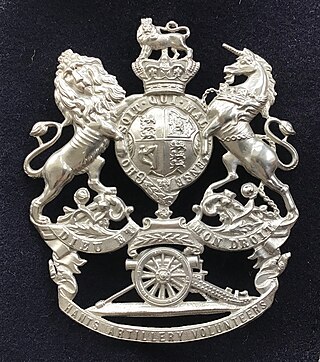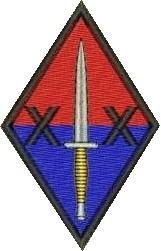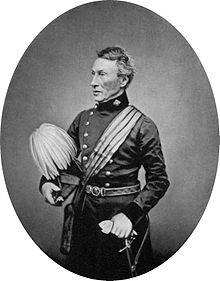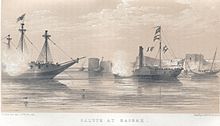
The Royal Regiment of Artillery, commonly referred to as the Royal Artillery (RA) and colloquially known as "The Gunners", is one of two regiments that make up the artillery arm of the British Army. The Royal Regiment of Artillery comprises thirteen Regular Army regiments, the King's Troop Royal Horse Artillery and five Army Reserve regiments.

The Royal Garrison Artillery (RGA) was formed in 1899 as a distinct arm of the British Army's Royal Regiment of Artillery serving alongside the other two arms of the Regiment, the Royal Field Artillery (RFA) and the Royal Horse Artillery (RHA). The RGA were the 'technical' branch of the Royal Artillery who were responsible for much of the professionalisation of technical gunnery that was to occur during the First World War. It was originally established to man the guns of the British Empire's forts and fortresses, including coastal artillery batteries, the heavy gun batteries attached to each infantry division and the guns of the siege artillery. The RGA was amalgamated with the RFA in 1924, from which time the only two arms within the Royal Regiment of Artillery have been the Royal Artillery and the Royal Horse Artillery.
1st Regiment Royal Horse Artillery is a regiment of the Royal Horse Artillery in the British Army. It currently serves in the armoured field artillery role, and is equipped with the AS90 self-propelled gun. The regiment is currently based at Larkhill Garrison, Larkhill. The regiment completed its move from Assaye Barracks, Tidworth, to Larkhill in June 2019.
7th Parachute Regiment, Royal Horse Artillery is a regiment of the Royal Artillery in the British Army. It currently serves in the field artillery role with 16 Air Assault Brigade Combat Team, and is equipped with the L118 Light Gun.
This is the Operation Herrick ground order of battle, which lists any British ground forces that have taken part in the duration of Operation Herrick between 2002 and 2014.

53 (Louisburg) Air Assault Battery is the second most senior artillery battery. Formed in 1740, the battery is currently part of 5th Regiment Royal Artillery and is based at Marne Barracks, Catterick, North Yorkshire. The battery operates in a Surveillance and Target Acquisition role in support of 16 Air Assault Brigade Combat Team.
The Tynemouth Volunteer Artillery claims to be the oldest volunteer artillery unit of the British Army. It served coastal and siege guns in World War I and World War II, and also served in the infantry role.

51st (London) Heavy Anti-Aircraft Regiment was a volunteer air defence unit of Britain's Territorial Army from 1922 until 1955. During World War II it served in Norway, The Blitz, North Africa, and finally in Italy until the end of the war in Europe, by which time a proportion of the regiment's personnel were African soldiers, and the guns were engaging ground targets rather than aircraft.
The 1st Durham Volunteer Artillery was a unit of Britain's Volunteer Force and Territorial Army from 1860 to 1956. During World War I, it was the only coastal defence unit to engage the enemy, and it also trained siege gunners for service on the Western Front. It continued its coast defence role in World War II, after which it was converted into air defence and engineer units.

The 1st Cornwall Artillery Volunteers were formed in 1860 as a response to a French invasion threat. They served as a Coast Artillery unit during both World Wars, and also manned batteries serving overseas. The unit continued in existence until the dissolution of Coast Artillery in the UK in 1956.

The 2nd Devonshire Artillery Volunteers was a unit of the British Volunteer Force and Territorial Army. The unit and its successors defended Plymouth Dockyard and the Devon coast from 1861 to 1961.

The East Riding Royal Garrison Artillery (ERRGA) was a part-time unit of Britain's Royal Artillery based at Hull in the East Riding of Yorkshire. It provided coastal defence artillery along the Humber Estuary from 1908 to 1956, manned siege batteries on the Western Front during World War I at the Somme and Ypres and played a role in the pursuit of the German army during the Hundred Days Offensive. It served as infantry in Allied-occupied Germany after World War II. Its successor units in the Territorial Army included anti-aircraft artillery and field engineers.

The 2nd Glamorganshire Artillery Volunteers was a part-time unit of the British Army that defended the coast of South Wales from 1890 to 1942. Although it never saw action in its coastal defence role, it formed several siege batteries of heavy howitzers for service on the Western Front and Italian Front in World War I.

The North Scottish Royal Garrison Artillery and its successors were Scottish part-time coast defence units of the British Army from 1908 to 1961. Although the unit saw no active service, it supplied trained gunners to siege batteries engaged on the Western Front during World War I.

The Clyde Royal Garrison Artillery and its successors were Scottish part-time coast defence units of the British Army from 1910 to 1967. Although they unit saw no active service, they supplied trained gunners to siege batteries engaged on the Western Front during World War I.

The Forth Royal Garrison Artillery and its successors were Scottish part-time coast defence units of the British Army from 1908 to 1956. Although they saw no active service, they supplied trained gunners to siege batteries engaged on the Western Front during World War I.

The 1st Hampshire Artillery Volunteers and its successors were part-time coast defence units of the British Army from 1860 to 1967. Although the units saw no action, they protected the Portsmouth area in both World Wars and supplied trained gunners to siege batteries engaged on the Western Front during World War I. The unit continued in the Territorial Army after World War II.

The 1st Dorsetshire Artillery Volunteers and its successors were part-time coast defence units of the British Army from 1859 to 1956. Although these units saw no action, they protected the Dorset Coast, including the naval base of Portland Harbour, in both World Wars and also supplied trained gunners to siege batteries engaged on the Western Front during World War I. The unit continued in the Territorial Army after World War II.

The 1st Lancashire Artillery Volunteers, popularly known as 'Brown's Corps', was an auxiliary unit of the British Army raised in Liverpool in 1859. As the Lancashire & Cheshire Royal Garrison Artillery in the Territorial Force it was responsible for defending the Mersey Estuary and the coastline of North West England. It was one of the few coast defence units to fire a shot during World War I but also provided personnel for a number of siege batteries that saw action on the Western Front. It continued in the coast defence role during World War II, at the end of which it sent troops to work in the rear areas in Europe. It was reformed postwar but was broken up when the coast artillery branch was abolished in 1956.

The 1st Suffolk & Harwich Volunteer Artillery, later the Essex & Suffolk Royal Garrison Artillery was an auxiliary coastal artillery unit of the British Army first raised in 1899. It defended the ports and naval bases around the estuaries of the Rivers Orwell and Stour. Although the unit saw no active service, it supplied trained gunners to siege batteries engaged on the Western Front during World War I. It was greatly expanded in World War II to defend the invasion-threatened East Anglian Coast from Harwich to Great Yarmouth. Postwar it continued in the coast and air defence roles until it disappeared in a series of amalgamations from the 1950s.











